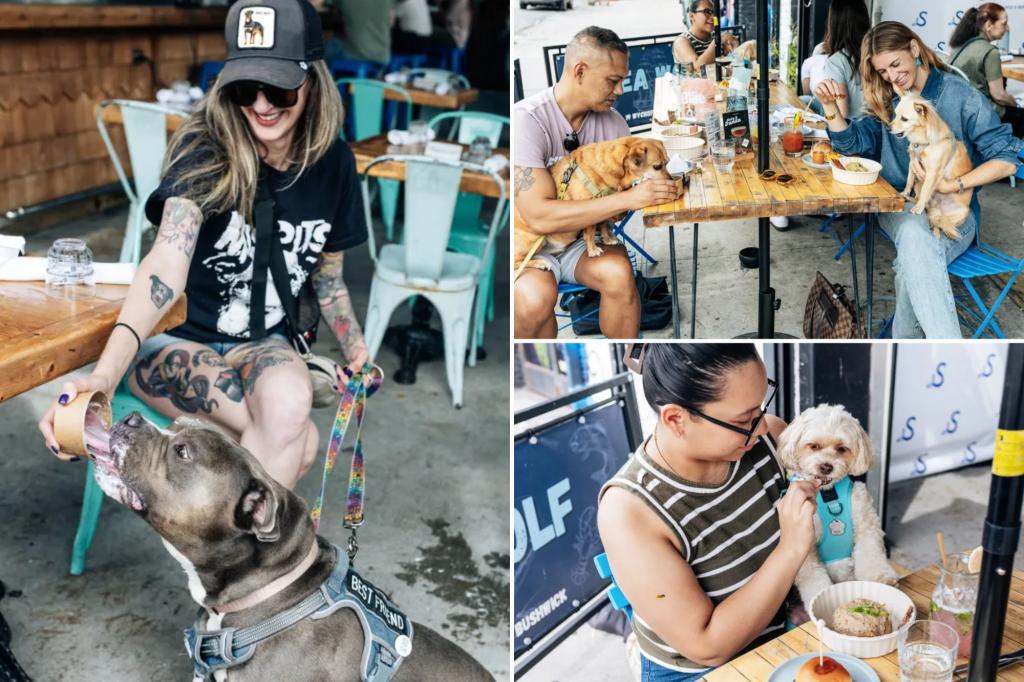From Dining to Dog Delights: Sea Wolf’s “Al La Bark” Menu Revolutionizes Pet-Friendly Dining in NYC
New York City’s vibrant culinary scene is experiencing a heartwarming transformation as Brooklyn seafood hotspot Sea Wolf prepares to launch its innovative “Al La Bark” menu on September 27th. This thoughtfully crafted dining experience caters exclusively to our four-legged companions, reflecting a growing trend of pet-friendly establishments across the city. The new canine cuisine offering represents more than just a marketing gimmick—it’s a recognition of how deeply integrated our pets have become in our social lives and the increasing desire of pet parents to share quality experiences with their furry family members. Sea Wolf’s initiative stands at the intersection of two powerful trends: Americans’ deepening bond with their pets and the evolving nature of dining as a holistic experience rather than merely a transaction of food service.
The “Al La Bark” menu delivers surprising sophistication and variety, featuring appetizers like salmon jerky, main courses combining high-quality proteins with nutritious sides (such as beef with sweet potatoes or turkey with blueberries), and even a coconut-based “puppuccino” for dessert. At just $9 for a three-course prix-fixe meal, the canine menu offers remarkable value compared to the restaurant’s human offerings like $42 lobster dinners or $31 grilled salmon plates. Restaurant representative Angelica Vergel explains the motivation behind this innovative concept: “Sea Wolf itself is already a dog destination, so we thought, why not make Sea Wolf even more pet friendly. We want to make sure every pet feels special when they’re there—just like their humans.” This sentiment captures the essence of what many modern pet owners seek—establishments that don’t merely tolerate their animals but actively welcome and accommodate them as valued guests.
The culinary expertise behind this menu comes from popular pet food maker Ollie, a company known for its fresh, nutritious dog food made with “human-grade” ingredients. This partnership elevates the offerings beyond typical pet treats to something more akin to the farm-to-table philosophy many humans seek in their own dining experiences. Bryan Angolia, Ollie’s brand chef, highlights both the culinary and practical benefits of the new menu: “We know that pet parents love to experience life with their dogs, and routinely take their dogs to restaurants with them. If your dog has a little bit anxiety or gets bored easily, it’s good to have that meal in front of them so they have something to do while you’re eating.” Sea Wolf is taking the implementation seriously, with Vergel noting that a dedicated team will cater exclusively to the canine clientele, using separate refrigeration facilities stocked with fresh ingredients delivered weekly—ensuring the same level of care and food safety standards applied to human meals.
This canine culinary development emerges against the backdrop of New York City’s increasingly dog-friendly dining landscape, where the lines between human and pet spaces continue to blur. The trend reflects a deeper societal shift in how Americans view their pets—no longer just animals but bona fide family members deserving of similar experiences and quality of life. The “pet humanization” phenomenon has accelerated dramatically in recent years, with Americans spending record amounts on premium pet food, accessories, healthcare, and experiences. Sea Wolf’s initiative taps into this emotional connection, recognizing that for many New Yorkers, a dining experience isn’t complete without their canine companions. The growing demand for pet-inclusive spaces represents a fundamental shift in consumer expectations, with many diners now factoring pet policies into their decisions about where to eat, socialize, and spend their leisure time.
However, the increasing presence of dogs in traditionally human dining spaces hasn’t been without controversy. The movement exists within a complex regulatory environment that balances federal Americans With Disabilities Act requirements with city Department of Health regulations. Some diners embrace the opportunity to make “a furry new friend over dinner,” while others, like Upper West Side lawyer Danit Sibovits, express concerns about hygiene: “It’s gross. I don’t want dog hair or slobber near my food.” These conflicting perspectives highlight the ongoing negotiation of shared public spaces and the challenges restaurants face in satisfying diverse customer preferences. Additionally, some establishments have reported issues with non-service animals being brought into spaces designated only for service animals, creating confusion around enforcement and compliance with existing regulations.
Sea Wolf’s “Al La Bark” menu represents more than just a novel dining concept—it symbolizes our evolving relationship with pets and the blending of previously separate spheres of human and animal experience. As restaurants and other businesses increasingly accommodate pets, we’re witnessing a reimagining of public spaces that reflects deeper changes in family structures and emotional connections. For many pet owners, the ability to include their dogs in dining experiences addresses practical needs (not leaving pets home alone) while also fulfilling emotional desires to share life’s pleasures with all family members, regardless of species. Whether this trend represents a positive societal evolution or an inappropriate blurring of boundaries remains subjective, but the economic response from businesses like Sea Wolf suggests that pet-inclusive experiences have significant market appeal. As we navigate this changing landscape, restaurants will likely continue developing creative solutions that balance the desires of pet owners with the comfort and expectations of other patrons—perhaps creating a new normal where sophisticated canine cuisine becomes as expected as children’s menus in family-friendly establishments.














